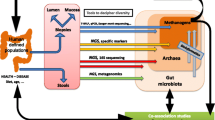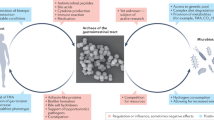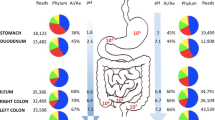Abstract
Background
Intestinal methane (CH4) gas production has been associated with a number of clinical conditions and may have important metabolic and physiological effects.
Aims
In this study, taxonomic and functional gene analyses and in vitro CH4 gas measurements were used to determine if molecular markers can potentially serve as clinical tests for colonic CH4 production.
Methods
We performed a cross-sectional study involving full stool samples collected from 33 healthy individuals. In vitro CH4 gas measurements were obtained after 2-h incubation of stool samples and used to characterize samples as CH4 positive (CH4+) and CH4 negative (CH4–; n = 10 and 23, respectively). Next, we characterized the fecal microbiota through high-throughput DNA sequencing with a particular emphasis on archaeal phylum Euryarchaeota. Finally, qPCR analyses, targeting the mcrA gene, were done to determine the ability to differentiate CH4+ versus CH4− samples and to delineate major methanogen species associated with CH4 production.
Results
Methanobrevibacter was found to be the most abundant methane producer and its relative abundance provides a clear distinction between CH4+ versus CH4− samples. Its sequencing-based relative abundance detection threshold for CH4 production was calculated to be 0.097%. The qPCR-based detection threshold separating CH4+ versus CH4− samples, based on mcrA gene copies, was 5.2 × 105 copies/g.
Conclusion
Given the decreased time-burden placed on patients, a qPCR-based test on a fecal sample can become a valuable tool in clinical assessment of CH4 producing status.



Similar content being viewed by others
References
Chaudhary PP, Conway PL, Schlundt J. Methanogens in humans: potentially beneficial or harmful for health. Appl Microbiol Biotechnol. 2018;102:3095–3104. https://doi.org/10.1007/s00253-018-8871-2.
Mathur R, Chua KS, Mamelak M, et al. Metabolic effects of eradicating breath methane using antibiotics in prediabetic subjects with obesity. Obesity (Silver Spring). 2016;24:576–582. https://doi.org/10.1002/oby.21385.
Pimentel M, Lin HC, Enayati P, et al. Methane, a gas produced by enteric bacteria, slows intestinal transit and augments small intestinal contractile activity. Am J Physiol Gastrointest Liver Physiol. 2006;290:G1089–G1095. https://doi.org/10.1152/ajpgi.00574.2004.
Hwang L, Low K, Khoshini R, et al. Evaluating breath methane as a diagnostic test for constipation-predominant IBS. Dig Dis Sci. 2010;55:398–403. https://doi.org/10.1007/s10620-009-0778-4.
Rezaie A, Buresi M, Lembo A, et al. Hydrogen and methane-based breath testing in gastrointestinal disorders: the North American consensus. Am J Gastroenterol. 2017;112:775–784. https://doi.org/10.1038/ajg.2017.46.
Low K, Hwang L, Hua J, Zhu A, Morales W, Pimentel M. A combination of rifaximin and neomycin is most effective in treating irritable bowel syndrome patients with methane on lactulose breath test. J Clin Gastroenterol. 2010;44:547–550. https://doi.org/10.1097/MCG.0b013e3181c64c90.
Pimentel M, Chang C, Chua KS, et al. Antibiotic treatment of constipation-predominant irritable bowel syndrome. Dig Dis Sci. 2014;59:1278–1285. https://doi.org/10.1007/s10620-014-3157-8.
Saad RJ, Chey WD. Breath testing for small intestinal bacterial overgrowth: maximizing test accuracy. Clin Gastroenterol Hepatol. 2014;12:1964–1972. https://doi.org/10.1016/j.cgh.2013.09.055. quiz e119-20.
Di Stefano M, Mengoli C, Bergonzi M, et al. Breath methane excretion is not an accurate marker of colonic methane production in irritable bowel syndrome. Am J Gastroenterol. 2015;110:891–898. https://doi.org/10.1038/ajg.2015.47.
McKay LF, Eastwood MA, Brydon WG. Methane excretion in man–a study of breath, flatus, and faeces. Gut. 1985;26:69–74. https://doi.org/10.1136/gut.26.1.69.
Borrel G, Harris HM, Parisot N, et al. Genome sequence of “Candidatus Methanomassiliicoccus intestinalis” Issoire-Mx1, a third thermoplasmatales-related methanogenic archaeon from human feces. Genome Announc. 2013;. https://doi.org/10.1128/genomea.00453-13.
Borrel G, Harris HM, Tottey W, et al. Genome sequence of “Candidatus Methanomethylophilus alvus” Mx1201, a methanogenic archaeon from the human gut belonging to a seventh order of methanogens. J Bacteriol. 2012;194:6944–6945. https://doi.org/10.1128/JB.01867-12.
Dridi B, Fardeau ML, Ollivier B, Raoult D, Drancourt M. Methanomassiliicoccus luminyensis gen. nov., sp. nov., a methanogenic archaeon isolated from human faeces. Int J Syst Evol Microbiol. 2012;62:1902–1907. https://doi.org/10.1099/ijs.0.033712-0.
Fricke WF, Seedorf H, Henne A, et al. The genome sequence of Methanosphaera stadtmanae reveals why this human intestinal archaeon is restricted to methanol and H2 for methane formation and ATP synthesis. J Bacteriol. 2006;188:642–658. https://doi.org/10.1128/JB.188.2.642-658.2006.
Gorlas A, Robert C, Gimenez G, Drancourt M, Raoult D. Complete genome sequence of Methanomassiliicoccus luminyensis, the largest genome of a human-associated Archaea species. J Bacteriol. 2012;194:4745. https://doi.org/10.1128/JB.00956-12.
Khelaifia S, Garibal M, Robert C, Raoult D, Drancourt M. Draft genome sequence of a human-associated isolate of Methanobrevibacter arboriphilicus, the lowest-G + C-content Archaeon. Genome Announc. 2014;. https://doi.org/10.1128/genomea.01181-13.
Khelaifia S, Garibal M, Robert C, Raoult D, Drancourt M. Draft genome sequencing of Methanobrevibacter oralis strain JMR01, isolated from the human intestinal microbiota. Genome Announc. 2014;. https://doi.org/10.1128/genomea.00073-14.
Khelaifia S, Raoult D, Drancourt M. A versatile medium for cultivating methanogenic archaea. PLoS ONE. 2013;8:e61563. https://doi.org/10.1371/journal.pone.0061563.
Miller TL, Wolin MJ. Methanosphaera stadtmaniae gen. nov., sp. nov.: a species that forms methane by reducing methanol with hydrogen. Arch Microbiol. 1985;141:116–122.
Miller TL, Wolin MJ, de Macario EC, Macario AJL. Isolation of Methanobrevibacter smithii from Human Feces. Appl Environ Microbiol. 1982;43:227–232.
Samuel BS, Hansen EE, Manchester JK, et al. Genomic and metabolic adaptations of Methanobrevibacter smithii to the human gut. PNAS. 2007;104:10643–10648.
de Araujo Filho HB, Carmo-Rodrigues MS, Mello CS, et al. Children living near a sanitary landfill have increased breath methane and Methanobrevibacter smithii in their intestinal microbiota. Archaea. 2014;2014:576249. https://doi.org/10.1155/2014/576249.
Ghoshal U, Shukla R, Srivastava D, Ghoshal UC. Irritable bowel syndrome, particularly the constipation-predominant form, involves an increase in Methanobrevibacter smithii, which is associated with higher methane production. Gut Liver. 2016;10:932–938. https://doi.org/10.5009/gnl15588.
Kim G, Deepinder F, Morales W, et al. Methanobrevibacter smithii is the predominant methanogen in patients with constipation-predominant IBS and methane on breath. Dig Dis Sci. 2012;57:3213–3218. https://doi.org/10.1007/s10620-012-2197-1.
Dridi B, Henry M, El Khechine A, Raoult D, Drancourt M. High prevalence of Methanobrevibacter smithii and Methanosphaera stadtmanae detected in the human gut using an improved DNA detection protocol. PLoS ONE. 2009;4:e7063. https://doi.org/10.1371/journal.pone.0007063.
Miller TL, Wolin MJ. Enumeration of Methanobrevibacter smithii in human feces. Arch Microbiol. 1982;131:14–18. https://doi.org/10.1007/bf00451492.
Yao CK, Rotbart A, Ou JZ, Kalantar-Zadeh K, Muir JG, Gibson PR. Modulation of colonic hydrogen sulfide production by diet and mesalazine utilizing a novel gas-profiling technology. Gut Microbes. 2018;9:510–522. https://doi.org/10.1080/19490976.2018.1451280.
Gohl DM, Vangay P, Garbe J, et al. Systematic improvement of amplicon marker gene methods for increased accuracy in microbiome studies. Nat Biotechnol. 2016;34:942–949. https://doi.org/10.1038/nbt.3601.
Caporaso JG, Kuczynski J, Stombaugh J, et al. QIIME allows analysis of highthroughput community sequencing data. Nat Methods. 2010;7:335–336. https://doi.org/10.1038/nmeth0510-335.
Bolger AM, Lohse M, Usadel B. Trimmomatic: a flexible trimmer for Illumina sequence data. Bioinformatics. 2014;30:2114–2120. https://doi.org/10.1093/bioinformatics/btu170.
Aronesty E. Comparison of sequencing utility programs. Open Bioinform J. 2013;7:1–8.
Masella AP, Bartram AK, Truszkowski JM, Brown DG, Neufeld JD. PANDAseq: PAired-eND Assembler for Illumina sequences. BMC Bioinform. 2012;13:31.
Edgar RC, Haas BJ, Clemente JC, Quince C, Knight R. UCHIME improves sensitivity and speed of chimera detection. Bioinformatics. 2011;27:2194–2200. https://doi.org/10.1093/bioinformatics/btr381.
Wang Q, Garrity GM, Tiedje JM, Cole JR. Naive Bayesian classifier for rapid assignment of rRNA sequences into the new bacterial taxonomy. Appl Environ Microbiol. 2007;73:5261–5267. https://doi.org/10.1128/AEM.00062-07.
Caporaso JG, Bittinger K, Bushman FD, DeSantis TZ, Andersen GL, Knight R. PyNAST: a flexible tool for aligning sequences to a template alignment. Bioinformatics. 2010;26:266–267. https://doi.org/10.1093/bioinformatics/btp636.
Edgar RC. Search and clustering orders of magnitude faster than BLAST. Bioinformatics. 2010;26:2460–2461. https://doi.org/10.1093/bioinformatics/btq461.
Quast C, Pruesse E, Yilmaz P, et al. The SILVA ribosomal RNA gene database project: improved data processing and web-based tools. Nucleic Acids Res. 2013;41:D590–D596. https://doi.org/10.1093/nar/gks1219.
Angel R, Claus P, Conrad R. Methanogenic archaea are globally ubiquitous in aerated soils and become active under wet anoxic conditions. ISME J. 2012;6:847–862. https://doi.org/10.1038/ismej.2011.141.
Steinberg LM, Regan JM. Phylogenetic comparison of the methanogenic communities from an acidic, oligotrophic fen and an anaerobic digester treating municipal wastewater sludge. Appl Environ Microbiol. 2008;74:6663–6671. https://doi.org/10.1128/AEM.00553-08.
Bustin SA, Benes V, Garson JA, et al. The MIQE guidelines: minimum information for publication of quantitative real-time PCR experiments. Clin Chem. 2009;55:611–622. https://doi.org/10.1373/clinchem.2008.112797.
Edgar RC. MUSCLE: multiple sequence alignment with high accuracy and high throughput. Nucleic Acids Res. 2004;32:1792–1797. https://doi.org/10.1093/nar/gkh340.
Youden WJ. Index for rating diagnostic tests. Cancer. 1950;3:32–35.
Segata N, Izard J, Waldron L, et al. Metagenomic biomarker discovery and explanation. Genome Biol. 2011;12:R60.
Samuel BS, Gordon JI. A humanized gnotobiotic mouse model of host–archaeal–bacterial mutualism. PNAS. 2006;103:10011–10016.
Hansen EE, Lozupone CA, Rey FE, et al. Pan-genome of the dominant human gut-associated archaeon, Methanobrevibacter smithii, studied in twins. Proc Natl Acad Sci U S A. 2011;108:4599–4606. https://doi.org/10.1073/pnas.1000071108.
Ruaud A, Esquivel-Elizondo S, de la Cuesta-Zuluaga J, et al. Syntrophy via interspecies H2 transfer between Christensenella and Methanobrevibacter underlies their global cooccurrence in the human Gut. mBio. 2020;. https://doi.org/10.1128/mbio.03235-19.
Mihajlovski A, Alric M, Brugere JF. A putative new order of methanogenic Archaea inhabiting the human gut, as revealed by molecular analyses of the mcrA gene. Res Microbiol. 2008;159:516–521. https://doi.org/10.1016/j.resmic.2008.06.007.
Fernandes J, Wang A, Su W, et al. Age, dietary fiber, breath methane, and fecal short chain fatty acids are interrelated in Archaea-positive humans. J Nutr. 2013;143:1269–1275. https://doi.org/10.3945/jn.112.170894.
Florin THJ, Woods HJ. Inhibition of methanogenesis by human bile. Gut. 1997;35:418–421.
Unal I. Defining an optimal cut-point value in ROC analysis: an alternative approach. Comput Math Methods Med. 2017;. https://doi.org/10.1155/2017/3762651.
Acknowledgment
University of Minnesota Center for Mass Spectrometry and Proteomics for conducting the short chain fatty acid analysis. We also thank the University of Minnesota Supercomputing Institute for providing resources.
Funding
Healthy Foods Healthy Lives (A.Kh); Achieving Cures Together (A.Kh); the University of Minnesota MnDRIVE Initiative (MJS); Allen Foundation (MJS).
Author information
Authors and Affiliations
Corresponding author
Ethics declarations
Conflicts of interest
All authors have declared no conflicts of interest.
Additional information
Publisher's Note
Springer Nature remains neutral with regard to jurisdictional claims in published maps and institutional affiliations.
Electronic Supplementary Material
Below is the link to the electronic supplementary material.
Rights and permissions
About this article
Cite this article
Teigen, L., Mathai, P.P., Matson, M. et al. Methanogen Abundance Thresholds Capable of Differentiating In Vitro Methane Production in Human Stool Samples. Dig Dis Sci 66, 3822–3830 (2021). https://doi.org/10.1007/s10620-020-06721-5
Received:
Accepted:
Published:
Issue Date:
DOI: https://doi.org/10.1007/s10620-020-06721-5




